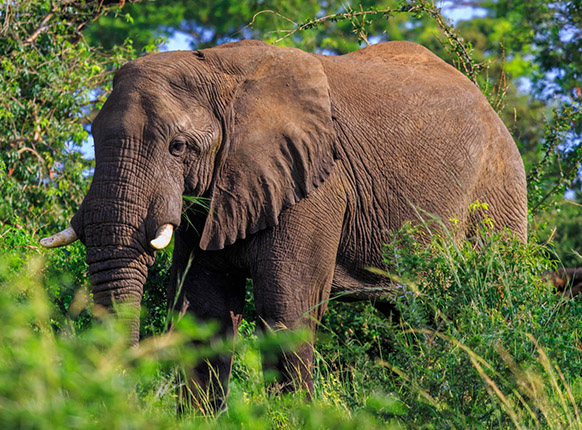- September 1, 2023
- Posted by: Editor2
- Category: Blog
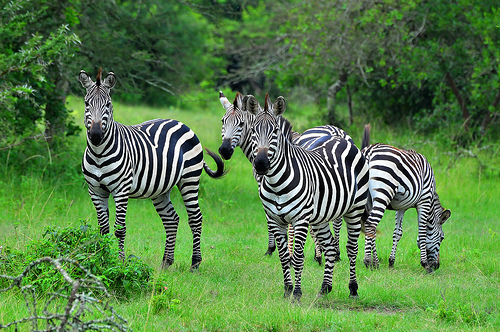
The experience is bigger than the park.
While Lake Mburo National Park is considered to be the smallest national park in Uganda, do not undermine its offers to those who pay a visit. The park is famous for having the most number of impalas and zebras in Uganda. This is in addition to having quite a number of elusive species of birds some of which are Rift Valley endemics.
Embarking on a safari to Lake Mburo National Park can be the best experience in Uganda since it comprises magical moments and activities. The park is the closest Lake to Kampala City and Entebbe International Airport – Uganda’s major entry points.
Lake Mburo is blessed in a way that even when you have not made it to the park, the experience on your way will have already gained a positive impression. These activities include among others but are not limited to; the Experiments at the Uganda Equator, Masaka city tour, Igongo Cultural Center, hiking to the Eclipse monument in Biharwe, Mbarara city tour, and visiting Nkokonjeru tombs.
It is high time you made your way to Lake Mburo National Park turning moments into memories has always been your dream. The park gives you a chance to satisfy your curiosity.
Where is Lake Mburo National Park located?
Lake Mburo National Park strides the district of Kiruhura in western Uganda. The park stretches to some parts of the Isingiro district close to the border of Uganda and Tanzania.
Before Lake Mburo National Park was divided, it stretched to some parts of Lyantonde district and on the other side of Mbarara – Masaka highway. Up to now, animals still cross the road but of course on rare occasions since wild animals do not like places frequented by people. Driving this road will give you an opportunity to have a glimpse of animals grazing by the roadsides. You will see zebras, impala, kopje, and buffaloes and these are just a few.
What is the size of Lake Mburo National Park? Is Lake Mburo National Park the smallest national park in Uganda?
Lake Mburo National Park covers a territory of approximately 260 square kilometers making it the smallest national park in Uganda. The park neighbors the districts of Mbarara and Isingiro. The parks consist of Lake Mburo and the swamps which support the ecosystem as far as water and food supply are concerned.
History of the park
Lake Mburo National Park traces its origin way back to 1933 a time when it was gazetted as a hunting area. Back then the entire region was bushy and there were few human settlements. The park stretched to the present Kiruhura district headquarters but later as humans encroached the park reduced to its present size.
In 1963, Lake Mburo National Park was declared a game reserve but encroachment and poaching continued as the Bahima of Ankole would graze their cattle in the gazetted area. It is such a background that in 1983, Lake Mburo game reserve gained the status of a national park. Since then Lake Mburo National Park has played a pivotal role in as far as wildlife and nature conservation is concerned. The park is currently a prime destination for birding, horseback riding safaris, and game drives.
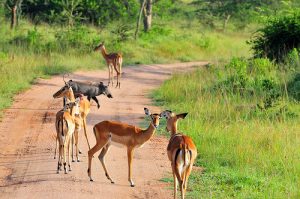
What can I do on a safari to Lake Mburo National Park? – Activities on a trip to Lake Mburo National Park.
- Experience at the Uganda Equator
- Masaka city tour
- Igongo Cultural Center and a hike to the Eclipse Monument
- Wildlife safari game drives (Both day and night)
- Birding Experience
- Ankole cultural tours / Community walks
- Horseback riding safaris
- Boat cruise and sport fishing at Lake Mburo
- Cycling
- Mbarara city tour and visiting Nkokonjeru tombs
-
Experience at the Uganda Equator
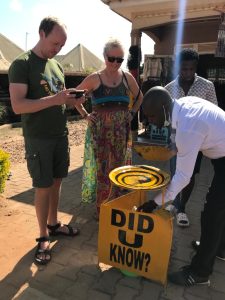
On your journey to Lake Mburo National Park, never miss the magical experience at the Uganda Equator. We all know that the earth is divided into two parts: the northern hemisphere and the Southern hemisphere. The imaginary line that does this division is the one known as the Equator.
Uganda is one of the few countries in Africa crossed by the equator line and one of the landmark areas is in Kayabwe – Mpigi district. This is just a few kilometers from Kampala city center. The other equator mark is located in Queen Elizabeth National Park. At all these points you get a chance to step into the two hemispheres of the earth at the same time. What a moment!
On the Uganda equator, you will perform the water balance as well as the weight loss experiments. You will as well take as many pictures as your memory can hold. This is just in the company of a cup of coffee or a plate of food.
At the Uganda equator in Mpigi, there is a craft shop from where you can grab something African particularly Ugandan which will always remind you of your trip to Lake Mburo National Park.
-
Masaka city tour
On your way to Lake Mburo National Park, you will pass by one of Uganda’s new cities – Masaka City. Here you will get an opportunity to see the real meaning of agro-tourism. This is after you have visited the coffee gardens and markets within the city.
Do not dare to miss the amazing cultural performances, crafts, and souvenir shops. You must not miss the sand beach experience at Lake Nabugabo as well as the Bukakata landing site.
All this comes with views of swamps, lush green vegetation as well as coffee and banana plantations. Masaka is one of the places that offers the best community tours in Uganda.
-
Igongo Cultural Centre & hike to the Eclipse monument
Just a few kilometers from Lake Mburo National Park’s Sanga gate and at the entrance of Mbarara city on Mbarara – Masaka road lies the magical Igongo Cultural Center.
This is one of the amazing cultural centers in Uganda particularly in western Uganda. It is a historical site in the lives of the Ankole kingdom – one of the ancient occupants of western Uganda.
Here you will enjoy the stories of Banyankole, taste their food, and get an insight into their traditional ways of life. You will get an opportunity to visit the library as well as take pictures of the Banyankole historical cow’s sculpture.
At the cultural center, you can enjoy the best accommodation and meals at Igongo Country Hotel.
After you have explored the Igongo Cultural Center, you will hike the opposite hill of Biharwe. Here you will get an opportunity to learn about the history of the Ankole kingdom and their long-horned cows. The Biharwe eclipse monument in Mbarara was erected on Biharwe Hill in commemoration of the “Biharwe Eclipse” which was dated by astronomers and historians to have taken place in the year 1520 AD. As the only scientifically dated event in the early history of the Great Lakes Region, the eclipse, which was acknowledged in legends of Bunyoro, Buganda, and Ankole, became the key benchmark that was used by historians to determine the royal genealogies of those kingdoms. The hill also provides scenic views of the surrounding areas including the city of Mbarara.
-
Wildlife safari game drives (Both day and night)
Most of the wildlife in the protected areas of Uganda is experienced while on game drives. In the case of Lake Mburo National Park, more options are availed for wild game viewing. In this Park, game drives are scheduled for three sessions, the morning game drive, the afternoon game drive, and the night game drive. The morning game drive in the park begins at 8:00 in the morning, taking about 2 to 3 hours of wildlife viewing. The evening game drive starts after lunch at 2 p.m. Nocturnal game drives are provided at the park for those who are interested in night mammals, this is a good chance for you to set an eye on leopard hunting.
-
Birding Safaris
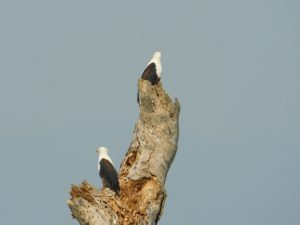
Are you a bird lover or do you dream of having the best birding safaris, consider visiting Lake Mburo national park? The park is home to multiple species such as the rare shoebill stork, Pelicans, Black Crake, Common Squacco, Striated, Goliath, Purple, Black-headed, Grey, and Black-headed Herons, to mention but a few. Some of these birds are elusive species and can only be found in this region.
-
Ankole cultural tours / Community walks
Walking safaris is another way of experiencing the beautiful wildlife of Lake Mburo. The lack of a lion’s presence in the park makes this possible. This favors walking safaris and nature walks through the park.
The morning hours are preferred for walking safaris as temperatures are low making it possible to walk longer distances. Additionally, at this time it is possible to see lots of wildlife. This activity takes about 2 hours of walking through the splendid wilderness of the park. The Rubanga forest and salt lick are some of the places that are suitable for the walk. These areas are home to many wildlife animals, including bird species.
Wildlife view on a walking safari is always led by a guide, who knows the paths and ways that take to the beautiful flora and fauna of the park. Besides the view of the splendid wildlife in the park, walking in Lake Mburo National Park rewards a view of 9 of the 14 lakes of Mburo.
The walk will take you to the neighboring Banyankole communities for the experience of their ways of life. You will get an understanding of how the long-horned Ankole cows are treasured within the region.
-
Horseback riding safaris
Wildlife in Lake Mburo National Park can be experienced while on a horse. Horseback safaris in Lake Mburo National Park are an enticing adventure in the park.
Wildlife viewing on horseback is done at the Mihingo Lodge inside the Park. Mihingo Lodge is a luxury lodge that offers horse ride services to guests interested. This activity is carried out in the middle of the park. It comes with rewarding views of 360 degrees of the 12 lakes that surround Lake Mburo National Park. A closer glimpse of wild game such as buffalos feeding, elands, Zebras, duikers, Topi among others is guaranteed.
Before the horse rides through the lake, the guests are required to take weight measurements. This helps to allocate the appropriate horse that matches the body weight of the guest. There is a limit of carriage for the horses, with a maximum weight of 100kg, though currently, the horses’ capacity to carry a person is 85kg.
A number of riding gear is provided before experiencing the wildlife on a horse in Lake Mburo National Park. Riding helmets and chaps are provided for the riders.
A horse safari takes 4 hours of wildlife viewing in the park. Advanced riders can take on the horses while beginners are advised to participate in walking safaris.
-
Boat cruise and sport fishing
A boat trip in the park is one of the most amazing experiences as it offers views of aquatic species such as crocodiles, hippos, and grey-crowned crested cranes roaming the swamps.
The boat cruises take place either in the morning or in the afternoon. If you are passionate about sport fishing, Lake Mburo should be top of your list. You will get an opportunity to catch multiple fish species in the company of the local members of the community.
-
Cycling
The other way of enjoying Lake Mburo National Park’s game is embarking on a cycling safari. This will give you an opportunity to exercise while seeing wildlife. It gives you an opportunity to see bird species in the best way possible.
-
Mbarara city tour and visiting Nkokonjeru tombs
Do not miss a tour of one of Uganda’s cleanest cities – Mbarara. Take pictures of the cow’s sculpture (Amahembe ge’nte) as you enter the city and have lunch at any local hotel. The people in the local markets are hospitable and a true reflection of Uganda’s welcoming culture.
Do not miss visiting the Nkokonjeru tombs for an added experience.
Does Lake Mburo National Park have lions?
Lake Mburo does not have lions much as they used to be there in the past years. The last male lion is believed to have escaped to Tanzania.
How to access Lake Mburo National Park.
By road; drive the 4 to 5hour drive Kampala – Masaka – Mbarara highway
By air; Fly from Kajansi airstrip to Nyakisharara airstrip in Mbarara and then drive a few kilometers to the Park.
How much is the Lake Mburo National Park entrance fee?
40 USD, 30 USD, and 20,000 UGX for foreign nonresidents, foreign residents, and members of the East African Community respectively.
What is the best time to visit Lake Mburo National Park?
The park is open all year round but the dry months of June to August and December to February are the best times for general wildlife viewing as animals gather around the lake and other water sources.
In a nutshell therefore, you have learnt the top 10 activities to do on a Lake Mburo National Park safari, Book one Now and explore the park.
 info@thegorillatrekking.com
info@thegorillatrekking.com  +256 392 177 127
+256 392 177 127 
